Surface Quality as a Factor Affecting the Functionality of Products Manufactured with Metal and 3D Printing Technologies
Abstract
1. Introduction
2. Novel Surface Coating Technologies
3. Surface Modification of Metal Products Manufactured by 3D Printing
4. The Impact of Surface Quality on the Functional Characteristics of Metal Products Manufactured Using Conventional Technologies and 3D Printing—Characterization and Application
5. Surface Engineering Market
- Engines (camshaft, crankshaft, valve lifters, valves, pistons, and suspension arms);
- Braking system (disk, pads, and drums)—transmission components (clutch, gears, differential, and pressure plate);
- Steering system.
6. Summary
- Skillful use of the latest technical and scientific achievements in coating production techniques.
- Automation of coating application processes.
- Based on knowledge from many fields of science, in particular on processes taking place at the atomic level.
- A high degree of usability and practical use, increasing the functionality of coated products.
- Putting a lot of effort into making surface technologies as environmentally friendly as possible.
- In the future, the development of surface coating technology will probably focus on the needs of the metal industry, which is key to consumer production.
- The development of surface technologies will be an integral part of Industry 5.0, the premise of which is to act for the benefit of consumers.
- Industry 5.0 reduces waste, which is reflected in technologies such as 3D printing. By using cheaper recycled metals and then covering them with functional coatings, the products can be used in various environmental conditions.
Author Contributions
Funding
Informed Consent Statement
Data Availability Statement
Conflicts of Interest
References
- Garvin, D.A. What Does “Product Quality” Really Means. Sloan Manag. Rev. 1984, 25–43. Available online: http://www.oqrm.org/English/What_does_product_quality_really_means.pdf (accessed on 18 June 2024).
- Kardas, E. The Assessment of Quality of Products Using Selected Quality Instrumentshe. Prod. Eng. Arch. 2016, 10, 5–8. Available online: http://www.qpij.pl (accessed on 18 June 2024). [CrossRef]
- Król, M.; Dobrzański, L.A.; Reimann, Ł.; Czaja, I. Surface Quality in Selective Laser Melting of Metal Powders. Arch. Mater. Sci. Eng. 2013, 60, 87–92. Available online: https://delibra.bg.polsl.pl/Content/30662/BCPS_34498_-_Surface-quality-in-s_0000.pdf (accessed on 18 June 2024).
- Mazur, I.; Koinov, T. Quality Control System for a Hot-Rolled Metal Surface. J. Chem. Technol. Metall. 2014, 49, 71–76. Available online: https://journal.uctm.edu/node/j2014-1/12-Mazur_Koinov-71-76.pdf (accessed on 18 June 2024). [CrossRef]
- Hao, L. Discussion on Surface Quality and Precision Control of Metal Materials in Machining Process. J. Phys. Conf. Ser. 2022, 2174, 012041. [Google Scholar] [CrossRef]
- Rius-Ayra, O.; Llorca-Isern, N. Special Issue “Surface Modification of Metals and Alloys”. Coatings 2021, 11, 260. [Google Scholar] [CrossRef]
- Ramezani, M.; Ripin, Z.M.; Pasang, T.; Jiang, C.-P. Surface Engineering of Metals: Techniques. Charact. Appl. Met. 2023, 13, 1299. [Google Scholar] [CrossRef]
- Filus, A.; Marcin Staszuk, M.; Cesarz-Andraczke, K. Struktura i Własności Odpornych na Korozję Powłok PVD i ALD. 2019. Available online: https://pimib.polsl.pl/pliki/imiib/8/Filus.pdf (accessed on 20 October 2024).
- Fotovvati, B.; Namdari, N.; Dehghanghadikolaei, A. On Coating Techniques for Surface Protection: A Review. J. Manuf. Mater. Process. 2019, 3, 28. [Google Scholar] [CrossRef]
- Maleki, E.; Bagherifard, S.; Bandini, M.; Guagliano, M. Surface post-treatments for metal additive manufacturing. Prog. Chall. Oppor. 2021, 37, 2214–8604. [Google Scholar] [CrossRef]
- Caggiano, A.; Teti, R.; Alfieri, V.; Caiazzo, F. Automated laser polishing for surface finish enhancement of additive manufactured components for the automotive industry. Prod. Eng. 2021, 15, 109–117. [Google Scholar] [CrossRef]
- Frantsen, J.E. Specifying Stainless Steel Surfaces for the Brewery, Dairy and Pharmaceutical Sectors, Presented at NACE Corrosion 2009, Paper 09573, Atlanta, GA, March 2009. Available online: https://forcetechnology.com/-/media/force-technology-media/pdf-files/unnumbered/corrosion-protection/reports-whitepapers-articles/nace-corrosion-2009---specifying-stainlesssteel-surfaces-for-the-brewery-dairy-and-pharmaceutical-sectors.pdf (accessed on 18 July 2024).
- Barbezat, G.; Crummenauer, J.; Avissar, J. Surface treatment selections for automotive applications. Surf. Coat. Technol. 2005, 200, 1962–1968. [Google Scholar] [CrossRef]
- Vignesh, E.; Sundararajan, T. Corrosion Prevention and Surface Engineering Practices in Auto-Components Industries. In A Treatise on Corrosion Science, Engineering and Technology; Indian Institute of Metals Series; Kamachi Mudali, U., Subba Rao, T., Ningshen, S., Pillai, R.G., George, R.P., Sridhar, T.M., Eds.; Springer: Singapore, 2020. [Google Scholar] [CrossRef]
- Balasubramanian, J.; Kumar, V.; Kirubakaran, M.; Lalwani, R. A Study on Automotive Sheetmetal Surface Pretreatment: Liquid Activation and Low Temperature Phosphating, Technical Papers. In Proceedings of the International Conference on Automotive Materials and Manufacturing AMM, Pune, India, 1–3 June 2023. [Google Scholar] [CrossRef]
- Grujicic, M.; Sellappan, V.; Omar, M.A.; Seyr, N.; Obieglo, A.; Erdmann, M.; Holzleitner, J. An overview of the polymer-to-metal direct-adhesion hybrid technologies for load-bearing automotive components. J. Mater. Process. Technol. 2008, 197, 363–373. [Google Scholar] [CrossRef]
- Merlo, A.M. The contribution of surface engineering to the product performance in the automotive industry. Surf. Coat. Technol. 2003, 174–175, 21–26. [Google Scholar] [CrossRef]
- Dearnley, P.A. 8—Surface Engineering for Automotive Engine Components. In Introduction to Surface Engineering; Cambridge University Press: Cambridge, UK, 20 January 2017. [Google Scholar] [CrossRef]
- Louda, P. Applications of thin coatings in automotive industry. J. Achiev. Mater. Manuf. Eng. 2007, 24, 1. Available online: http://jamme.acmsse.h2.pl/papers_vol24_1/24105.pdf (accessed on 18 June 2024).
- Bewilogua, K.; Bräuer, G.; Dietz, A.; Gäbler, J.; Goch, G.; Karpuschewski, B.; Szyszka, B. Surface technology for automotive engineering. Eng. Mater. Sci. CIRP Ann. —Manuf. Technol. 2009, 58, 608–627. [Google Scholar] [CrossRef]
- Brand, J. Functional Coatings for the Automotive Industry. 2024. Available online: https://www.google.com.hk/url?sa=t&source=web&rct=j&opi=89978449&url=https://www.hybridleichtbau.fraunhofer.de/content/dam/hybridleichtbau/en/documents/research-expertise/mobility/Functional-Coatings-for-the-Automotive-Industry.pdf&ved=2ahUKEwjRueyvzLyJAxUL8DQHHfWUA-8QFnoECBUQAQ&usg=AOvVaw2hSA6yHjFuL3lZTvSpoc40 (accessed on 18 June 2024).
- Saraçyakupoğlu, T. Abrasive Water Jet (AWJ) Applications in the Aviation Industry. 2019, 9, p. 6. Available online: https://hdl.handle.net/11363/1587 (accessed on 18 June 2024).
- Wu, D.; Liu, S.; Wang, H. High surface integrity machining of typical aviation difficult-to-machine material blade. Int. J. Adv. Manuf. Technol. 2023, 129, 2861–2873. [Google Scholar] [CrossRef]
- Seçgin, Ö.; Sogut, M.Z. Surface roughness optimization in milling operation for aluminum alloy (Al 6061-T6) in aviation manufacturing elements. Aircr. Eng. Aerosp. Technol. 2021, 93, 1367–1374. [Google Scholar] [CrossRef]
- Ratul, R.I.; Rudra, A.D. New aerospace surface treatments and their prospects. Int. Res. J. Mod. Eng. Technol. Sci. 2023, 5, 461–466. Available online: www.irjmets.com (accessed on 18 June 2024).
- Nicolas, N.; Rochus, P.; Collette, J.P.; Crahay, J.; Jochem, H.; Larnicol, M.; Magnien, J.; Masse, C.; Rigo, O.; Vanhumbeeck, J.F.; et al. Surface Engineering for Parts Made by Additive Manufacturing, 66th International Astronautical Congress, Jerusalem, Israel. Copyright ©2015 by the International Astronautical Federation, IAC-15,C2,8,7,x30229. Available online: https://orbi.uliege.be/bitstream/2268/190049/1/IAC-2015_SCAMP_15_9_14.pdf (accessed on 18 July 2024).
- Ünaldi, S.; Papadopoulos, K.; Rondepierre, A.; Rouchausse, Y.; Karanika, A.; Deliane, F.; Tserpes, K.; Floros, G.; Richaud, E.; Laurent Berthe, L. Towards selective laser paint stripping using shock waves produced by laser-plasma interaction for aeronautical applications on AA 2024 based substrates. Opt. Laser Technol. 2021, 141, 107095. [Google Scholar] [CrossRef]
- Monografie, Studia, Rozprawy, Wydawnictwo Politechniki Świętokrzyskiej w Kielcach, Kielce 2011, M17, pod redakcją, Bogdana Antoszewskiego, Inżynieria Powierzchni, Wybrane Zagadnienia, Monographs, Studies, Dissertations, Kielce University of Technology Publishing House, Kielce 2011, M17, Edited by Bogdan Antoszewski, (Surface Engineering, Selected Issues, Monographs, Studies, Dissertations, Kielce University of Technology Publishing House, Kielce 2011, M17, Edited by Bogdan Antoszewski, Surface Engineering, Selected Issues, Monographs, Studies). Available online: http://bc.tu.kielce.pl/id/eprint/80 (accessed on 18 July 2024).
- Frost, O. Why Automotive Paint is Essential for Vehicle Manufacturers. AZoM, 4D Technology. 2024. Available online: https://www.azom.com/article.aspx?ArticleID=22067 (accessed on 22 June 2024).
- Pop, A.B.; Pop, G.J.; Gusan, V.; Țîțu, A.M. Surface Treatment in Aerospace Industry: A Study on Acid Pickling and Paint Adhesion. Int. J. Mechatron. Appl. Mech. 2023, 13, 58–69. [Google Scholar]
- Pendar, M.-R.; Rodrigues, F.; Páscoa, J.C.; Lima, R. Review of coating and curing processes: Evaluation in automotive industry. Physic Fluids 2022, 34, 10. [Google Scholar] [CrossRef]
- Sun, Y. Surface Engineering & Coating Technologies for Corrosion and Tribocorrosion Resistance. Materials 2023, 16, 4863. [Google Scholar] [CrossRef]
- Hernández-Peña, A.; Gallardo-Hernández, E.A.; Farfan-Cabrera, L.I.; Vite-Torres, M.; Muñoz-Saldaña, J. Solid particle erosion evaluation of automotive paint coatings under the influence of artificial weathering. Wear 2023, 532–533, 205105. [Google Scholar] [CrossRef]
- Klockea, F.; Kampker, A.; Döbbeler, B.; Mauea, A.; Schmieder, M. Simplified Life Cycle Assessment of a Hybrid Car Body Part. 21st CIRP Conference on Life Cycle Engineering, Procedia CIRP 15. 2014, pp. 484–489. Available online: www.sciencedirect.com (accessed on 18 July 2024).
- Marques, A.C.; Mocanu, A.; Tomi’c, N.Z.; Balos, S.; Stammen, E.; Lundevall, A.; Abrahami, S.T.; Roman Günther, R.; de Kok, J.M.M.; de Freitas, S.T. Review on Adhesives and Surface Treatments for Structural Applications: Recent Developments on Sustainability and Implementation for Metal and Composite Substrates. Materials 2020, 13, 5590. [Google Scholar] [CrossRef] [PubMed]
- Baptista, A.; Silva, F.; Porteiro, J.; Míguez, J.; Pinto, G. Sputtering Physical Vapour Deposition (PVD) Coatings: A Critical Review on Process Improvement and Market Trend Demands. Coatings 2018, 8, 402. [Google Scholar] [CrossRef]
- Tien, C.-L. Special Issue “Advanced Coating Technology by Physical Vapor Deposition and Applications”. Coatings 2023, 13, 467. [Google Scholar] [CrossRef]
- Gudmundsson, J.T.; Anders, A.; Keudell, A. Foundations of physical vapor deposition with plasma assistance, Topical Review. Plasma Sources Sci. Technol. 2022, 31, 083001. [Google Scholar] [CrossRef]
- Jia, K.; Zhang, J.; Zhu, Y.; Sun, L.; Lin, L.; Liu, Z. Chemical vapour deposition. Nat. Rev. Methods Primers 2021, 1, 6. [Google Scholar] [CrossRef]
- Kumar, A.; Jaiswal, J.; Tsuchiya, K.; Mulik, R.S. Modern Coating Processes and Technologies. In Coating Materials. Materials Horizons: From Nature to Nanomaterials; Verma, A., Sethi, S.K., Ogata, S., Eds.; Springer: Singapore, 2023. [Google Scholar] [CrossRef]
- Haubner, R.; Rauchenwald, E.; Lessiak, M.; Pitonak, R.; Weissenbacher, R. Novel High-Performance CVD Coatings for Machining Applications. Powder Metall. Prog. 2018, 18, 128–138. [Google Scholar] [CrossRef]
- Zhang, X.; Lai, J.; Gray, T. Recent progress in low-temperature CVD growth of 2D materials. Oxf. Open Mater. Sci. 2023, 3, 1. [Google Scholar] [CrossRef]
- Azadi, M.; Rouhaghdamb, A.S.; Ahangarani, S. A Review on Titanium Nitride and Titanium Carbide Single and Multilayer Coatings deposited by Plasma Assisted Chemical Vapor Deposition. Int. J. Eng. IJE Trans. B Appl. 2016, 29, 677–687. [Google Scholar]
- The Science and Engineering of Thermal Spray Coatings Second Edition the Science and Engineering of Thermal Spray Coatings, 2nd ed.; John Wiley & Sons, Ltd.: Hoboken, NJ, USA, 2008; ISBN 978-0-471-49049-4.
- Boshkov, N.; Petrov, K.; Raichevski, G. Corrosion behavior and protective ability of multilayer Galvanic coatings of Zn and Zn–Mn alloys in sulfate containing medium. Surf. Coat. Technol. 2006, 200, 5995–6001. [Google Scholar] [CrossRef]
- Böőr, K. Chemical Vapor Deposition of Hard Coatings. Acta Universitatis Upsaliensis. Uppsala. 2022. Available online: https://www.diva-portal.org/smash/get/diva2:1706347/FULLTEXT01.pdf (accessed on 18 June 2024).
- Colombo-Pulgarín, J.C.; Egea, A.J.S.; Celentano, D.J.; Krahmer, D.M.; Martynenko, V.; Lacalle, N.L. Mechanical and Chemical Characterisation of TiN and AlTiSiN Coatings on a LPBF Processed IN718 Substrate. Materials 2021, 14, 4626. [Google Scholar] [CrossRef]
- Escher, C.; Henke, T. New Trends in Thin Coatings for Sheet- Metal Forming Tools. In Proceedings of the 6th International Tooling Conference: The Use of Tool Steels: Experience and Research, Karlstad, Sweden, 10–13 September 2002; Jens Bergström, Karlstad University: Karlstad, Sweden, 2002–2004; Volume 2, pp. 919–933. [Google Scholar]
- Available online: https://www5.kau.se/sites/default/files/Dokument/subpage/2010/02/64_919_934_pdf_16347.pdf (accessed on 18 June 2024).
- Czupryński, A.A.; Górka, J.; Adamiak, M.; Tomiczek, B. Testing of Flame Sprayed Al2O3 Matrix Coatings Containing TiO2. Arch. Metall. Mater. 2016, 61, 1363–1370. [Google Scholar] [CrossRef]
- Chicot, D.; Ageorges, H.; Voda, M.; Louis, G.; Ben Dhia, M.A.; Palacio, C.C.; Kossman, S. Hardness of thermal sprayed coatings: Relevance of the scale of measurement. Surf. Coat. Technol. 2015, 268, 173–176. [Google Scholar] [CrossRef]
- Kacprzyńska-Gołacka, J.; Mazurkiewicz, A.; Smolik, J. Influence of PVD Coatings on Fatigue Properties of Hybrid Layers in High Temperatures. Probl. Eksploat. —Maint. Probl. 2013, 3, 45–54. [Google Scholar]
- Chen, X.; Zheng, B.; Zhou, S.; Shi, C.; Liang, Y.; Hu, L. Development and Application of Intelligent Coating Technology: A Review. Coatings 2024, 14, 597. [Google Scholar] [CrossRef]
- Maroun, G. Smart Coatings: The Future of Surface Technology, 12 August 2023. Available online: https://www.eura-ag.com/en/blog/smart-coatings-the-future-of-surface-technology (accessed on 18 June 2024).
- Brooman, E.W. Emerging Surface Finishing Technologies. Available online: https://sterc.org/pdf/psf2007/100724.pdf (accessed on 18 June 2024).
- Ganesh, V.A.; Raut, H.K.; Nair, A.S.; Ramakrishna, S. A review on self-cleaning coatings. J. Mater. Chem. 2011, 21, 16304. [Google Scholar] [CrossRef]
- Zhang, H.; Wu, Y.; Wang, F.; Nestle, B. Effect of wall free energy formulation on the wetting phenomenon: Conservative Allen–Cahn model. J. Chem. Phys. 2023, 159, 164701. [Google Scholar] [CrossRef]
- Hasegawa, M.; Endo, H.; Morita, K.; Sakaue, H.; Kimura, S. Behavior of Sliding Angle as Function of Temperature Difference between Droplet and Superhydrophobic Coating for Aircraft Ice Protection Systems. Aerospace 2021, 8, 219. [Google Scholar] [CrossRef]
- Beitollahpoor, M.; Farzam, M.; Pesika, N.S. Determination of the Sliding Angle of Water Drops on Surfaces from Friction Force Measurements. Langmuir 2022, 38, 2132–2136. [Google Scholar] [CrossRef] [PubMed]
- Piscitelli, F.; Tescione, F.; Mazzola, L.; Bruno, G.; Lavorgna, M.M. On a simplified method to produce hydrophobic coatings for aeronautical applications. Appl. Surf. Sci. 2019, 472, 71–81. [Google Scholar] [CrossRef]
- Zhang, Y.; Zhou, S.; Lv, Z.; Fan, L.; Huang, Y.; Liu, X. A Facile Method to Prepare Superhydrophobic Coatings for Various Substrates. Appl. Sci. 2022, 12, 1240. [Google Scholar] [CrossRef]
- Vazirinasab, E.; Jafari, R.; Momen, G. Application of superhydrophobic coatings as a corrosion barrier: A review. Surf. Coat. Technol. 2018, 341, 40–56. [Google Scholar] [CrossRef]
- Calabrese, L.; Khaskhoussi, A.; Patane, S.; Proverbio, E. Assessment of Super-Hydrophobic Textured Coatings on AA6082 Aluminum Alloy. Coatings 2019, 9, 352. [Google Scholar] [CrossRef]
- Liu, J.; Janjua, Z.A.; Roe, M.; Xu, F.; Turnbull, B.; Choi, K.; Hou, X. Super-Hydrophobic/Icephobic Coatings Based on Silica Nanoparticles Modified by Self-Assembled Monolayers. Nanomaterials 2016, 6, 232. [Google Scholar] [CrossRef]
- AL-kawaz, A.E.; Kadhim, B.J.; Hussein, A.A. Smart Coatings: A Review of Recent Advances. Eur. J. Res. Dev. Sustain. 2023, 4, 10. Available online: https://www.scholarzest.com (accessed on 18 June 2024).
- Mishra, V.K.; Saini, R.; Kumar, N. A review on superhydrophobic materials and coating. IOP Conf. Ser. Mater. Sci. Eng. 2021, 1168, 012026. [Google Scholar] [CrossRef]
- Ma, M.; Hill, R.M. Superhydrophobic surfaces. Colloid Interface Sci. 2006, 11, 193–202. [Google Scholar] [CrossRef]
- Rabajczyk, A.; Zielecka, M.; Klapsa, W.; Dziechciarz, A. Self-Cleaning Coatings and Surfaces of Modern Building Materials for the Removal of Some Air Pollutants. Materials 2021, 14, 2161. [Google Scholar] [CrossRef]
- RSC Smart Materials, Self-Cleaning Coatings, Structure, Fabrication and Application, Edited by Junhui He, Royal Society of Chemistry, 2017, No 1, The Royal Society of Chemistry 2017, Published by the Royal Society of Chemistry, Thomas Graham House, Science Park, Milton Road, Cambridge CB4 0WF, UK, United Kingdom by CPI Group (UK) Ltd. Available online: www.rsc.org (accessed on 18 June 2024).
- Butt, M.A. Thin-Film Coating Methods: A Successful Marriage of High-Quality and Cost-Effectiveness—A Brief Exploration. Coatings 2022, 12, 1115. [Google Scholar] [CrossRef]
- Jiang, P.; Ji, Z.; Wang, X.; Zhoua, F. Surface functionalization—A new functional dimension added to 3D printing. J. Mater. Chem. C 2020, 36, 8. [Google Scholar] [CrossRef]
- Huang, W.; Nelson, B.; Tian, S.; Ordikhani-Seyedlar, R.; Auyeung, R.C.Y.; Samanta, A.; Hui Hu, H.; Scott Shaw, S.; Lamuta, C.; Ding, H. Superhydrophobic surface processing for metal 3D printed parts. Appl. Mater. Today 2022, 29, 101630. [Google Scholar] [CrossRef]
- Wu, C.; Chen, Y.; Wei, X.; Xu, J.; Li, D. Morphology analysis and process optimization of μ-SLA 3D manufactured micro-nano conic structure. J. Intell. Manuf. Spec. Equip. 2024. Available online: https://www.emerald.com/insight/2633-6596.htm (accessed on 18 June 2024).
- Wang, X.; Liu, J.; Yang, L.; He, Y.; Wang, Y. Nano-sized amorphous carbon covered surface formed by selective laser melting of ink-printed (SLM-IP) copper (Cu) nanoparticles (NPs). Appl. Surf. Sci. 2018, 448, 133–137. [Google Scholar] [CrossRef]
- Wu, C.; Wei, X.; Chen, Y.; Liu, J.; Guo, C.; Wang, Q.; Liang, S.Y. Surface wettability analysis and preparation of hydrophobic microcylindrical arrays by μ-SLA 3D printing. J. Manuf. Process. 2022, 83, 14–26. [Google Scholar] [CrossRef]
- Zhao, W.; Zhan, Y.; Li, W.; Haoa, S.; Amirfazli, A. Application of 3D printing for fabrication of superhydrophobic surfaces with reversible wettability. R. Soc. Chem. 2024, 14, 17684–17695. [Google Scholar] [CrossRef]
- Chakka, L.R.; Chatterjee, K. Surface functionalization of 3D printed polymer scaffolds to augment stem cell response. Mater. Des. 2019, 161, 44–54. [Google Scholar] [CrossRef]
- Parthasarathy, J.; Starly, B.; Raman, S. A design for the additive manufacture of functionally graded porous structures with tailored mechanical properties for biomedical applications. J. Manuf. Process. 2011, 13, 160–170. [Google Scholar] [CrossRef]
- Bose, S.; Vahabzadeh, S.; Bandyopadhyay, A. Bone tissue engineering using 3D printing. Mater. Today 2013, 16, 496–504. [Google Scholar] [CrossRef]
- Chen, M.; Le, D.Q.; Baatrup, A.; Nygaard, J.V.; Hein, S.; Bjerre, L.; Kassem, M.; Zou, X.; Bünger, C. Self-assembled composite matrix in a hierarchical 3-D scaffold for bone tissue engineering. Acta Biomater. 2011, 7, 2244–2255. [Google Scholar] [CrossRef]
- Hong, J.M.; Kim, B.J.; Shim, J.-H.; Kang, K.S.; Kim, K.-J.; Rhie, J.W.; Cha, H.J.; Cho, D.-W. Enhancement of bone regeneration through facile surface functionalization of solid freeform fabrication-based three-dimensional scaffolds using mussel adhesive proteins. Acta Biomater. 2012, 8, 2578–2586. [Google Scholar] [CrossRef] [PubMed]
- Tian, Y.; Chen, C.; Xu, X.; Wang, J.; Hou, X.; Li, K.; Lu, X.; Shi, H.; Lee, E.-S.; Jiang, H.B. A Review of 3D Printing in Dentistry: Technologies, Affecting Factors, and Applications. Scanning 2021, 2021, 9950131. [Google Scholar] [CrossRef] [PubMed]
- Gao, J.; Pan, Y.; Gao, Y.; Pang, H.; Sun, H.; Cheng, L.; Liu, J. Research Progress on the Preparation Process and Material Structure of 3D-Printed Dental Implants and Their Clinical Applications. Coatings 2024, 14, 781. [Google Scholar] [CrossRef]
- Deppe, H.; Wolff, C.; Bauer, F.; Ruthenberg, R.; Sculean, A.; Mücke, T. Dental implant surfaces after insertion in bone: An in vitro study in four commercial implant systems. Clin. Oral Investig. 2018, 22, 1593–1600. [Google Scholar] [CrossRef] [PubMed]
- Qin, J.; Yang, D.; Maher, S.; Lima-Marques, L.; Zhou, Y.; Chen, Y.; Atkins, G.J.; Losic, D. Micro- and nano-structured 3D printed titanium implants with a hydroxyapatite coating for improved osseointegration. J. Mater. Chem. B 2018, 6, 3136–3144. [Google Scholar] [CrossRef] [PubMed]
- Yu, M.; Wan, Y.; Ren, B.; Wang, H.; Zhang, X.; Qiu, C.; Liu, A.; Liu, Z. 3D Printed Ti–6Al–4V Implant with a Micro/Nanostructured Surface and Its Cellular Responses. ACS Omega 2020, 5, 31738–31743. [Google Scholar] [CrossRef]
- Orłowska, A.; Kajzer, W.; Goldsztajn, K.; Gawron, A.; Godzierz, M.; Nowińska, K.; Basiaga, M.; Wojciech Simka, W.; Szewczenko, J. Functionalization of 3D printed Ti6Al4V high-porous spinal implant surface with use of plasma electrolytic oxidation. Appl. Surf. Sci. 2024, 659, 159948. [Google Scholar] [CrossRef]
- Ferrari, M.; Benedetti, A. Superhydrophobic surfaces for applications in seawater. Adv. Colloid Interface Sci. 2015, 222, 291–304. [Google Scholar] [CrossRef]
- Cheirmakani, B.M.; Karthikeyan, M.; Balamurugan, S.; Robert, R.B.J. Development of superhydrophobic surface on mild steel by a facile approach and analyzing its self-cleaning and anti-freezing properties. Results Surf. Interfaces 2024, 14, 100200. [Google Scholar] [CrossRef]
- Ma, C.; Dong, Y.; Ye, C. Improving Surface Finish of 3D-printed Metals by Ultrasonic Nanocrystal Surface Modification. Procedia CIRP 2016, 45, 319–322. [Google Scholar] [CrossRef]
- Hae-Sung, Y.; Jang, K.-H.; Kim, E.; Lee, H.-T.; Ahn, S.-H. Hybrid 3D printing by bridging micro/nano processes. J. Micromech. Microeng 2017, 27, 065006. [Google Scholar] [CrossRef]
- Elder, B.; Neupane, R.; Tokita, E.; Ghosh, U.; Hales, S.; Kong, Y.L. Nanomaterial Patterning in 3D Printing. Adv. Mater. 2020, 32, 1907142. [Google Scholar] [CrossRef]
- Acquah, S.F.A.; Leonhardt, B.E.; Nowotarski, M.S.; Magi, J.M.; Chambliss, K.A.; Venzel, T.E.S.; Sagar, D.; Delekar, S.D.; Al-Hariri, L.A. Carbon nanotubes and graphene as additives in 3D printing. In Carbon Nanotubes-Current Progress of Their Polymer Composites; Berber, M.R., Hafez, I.H., Eds.; IntechOpen: London, UK, 2016; pp. 227–251. [Google Scholar] [CrossRef]
- Marovič, N.; Ban, I.; Maver, U.; Maver, T. “Magnetic nanoparticles in 3D-printed scaffolds for biomedical applications”. Nanotechnol. Rev. 2023, 12, 20220570. [Google Scholar] [CrossRef]
- Petretta, M.; Gambardella, A.; Desando, G.; Cavallo, C.; Bartolotti, I.; Shelyakova, T.; Goranow, V.; Brucale, M.; Dediu, V.A.; Fini, M.; et al. Multifunctional 3D-printed magnetic polycaprolactone/hydroxyapatite scaffolds for bone tissue engineering. Polymers 2021, 13, 3825. [Google Scholar] [CrossRef] [PubMed]
- Dang, W.; Li, T.; Li, B.; Ma, H.; Zhai, D.; Wang, X.; Chang, J.; Xiao, Y.; Wang, J.; Wu, C. A bifunctional scaffold with CuFeSe2 nanocrystals for tumor therapy and bone reconstruction. Biomaterials 2018, 160, 92–106. [Google Scholar] [CrossRef] [PubMed]
- Rahman, M.; Islam, K.I.; Dip, T.M.; Farhad, M.; Chowdhury, M.; Debnath, S.R.; Hasan, S.M.M.; Sakib, M.S.; Saha, T.; Padhye, R.; et al. A review on nanomaterial-based additive manufacturing: Dynamics in properties, prospects, and challenges. Prog. Addit. Manuf. 2024, 9, 1197–1224. [Google Scholar] [CrossRef]
- Ghaziof, S.; Shojaei, S.; Mehdikhani, M.; Khodaei, M.; Nodoushan, M.J. Electro-conductive 3D printed polycaprolactone/gold nanoparticles nanocomposite scaffolds for myocardial tissue engineering. J. Mech. Behav. Biomed. Mater. 2022, 132, 105271. [Google Scholar] [CrossRef]
- Vidakis, N.; Petousis, M.; Velidakis, E.; Mountakis, N.; Tsikritzis, D.; Gkagkanatsious, A.; Kanellopoulou, S. Investigation of the biocidal performance of multi-functional resin/copper nanocomposites with superior mechanical response in SLA 3D printing. Biomimetics 2022, 7, 8. [Google Scholar] [CrossRef]
- Yang, Y.; Yong, C.; Zhong, J.; Huang, R.; Tan, W.; Tan, Z. An effective thermal therapy against cancer using an E-jet 3D-printing method to prepare implantable magnetocaloric mats. J. Biomeical Mater. Res. B Appl. Biomater. 2018, 106, 1827–1841. [Google Scholar] [CrossRef]
- Hales, S.; Tokita, E.; Neupane, R.; Ghosh, U.; Elder, B.; Wirthlin, D.; Kong, Y.L. 3D printed nanomaterial-based electronic, biomedical, and bioelectronic devices. Nanotechnology 2020, 31, 172001. [Google Scholar] [CrossRef]
- Muldoon, K.; Song, Y.; Ahmad, Z.; Chen, X.; Chang, M.-W. High Precision 3D Printing for Micro to Nano Scale Biomedical and Electronic Devices. Micromachines 2022, 13, 642. [Google Scholar] [CrossRef] [PubMed]
- Wang, N.; Zhang, R.; Liu, K.; Zhang, Y.; Shi, X.; Sand, W.; Hou, B. Application of nanomaterials in antifouling: A review. Nano Mater. Sci. 2024; in press. ISSN 2589-9651. [Google Scholar] [CrossRef]
- Bouranta, A.; Ioan Valentin Tudose, I.V.; Luciana Georgescu, L.; Anna Karaiskou, A.; Vrithias, N.R.; Viskadourakis, Z.; Kenanakis, G.; Sfakaki, E.; Mitrizakis, N.; Strakantounas, G.; et al. 3D Printed Metal Oxide-Polymer Composite Materials for Antifouling Applications. Nanomaterials 2022, 12, 917. [Google Scholar] [CrossRef] [PubMed]
- Richert, M.; Mazurkiewicz, A.; Smolik, J. Chromium carbide coatings obtained by the hybrid PVD methods. J. Achiev. Mater. Manuf. Eng. 2010, 43, 1. [Google Scholar]
- Chowdhury, S.; Beake, B.D.; Yamamoto, K.; Bose, B.; Aguirre, M.; Fox-Rabinovich, G.S.; Veldhuis, S.C. Improvement of Wear Performance of Nano-Multilayer PVD Coatings under Dry Hard End Milling Conditions Based on Their Architectural Development. Coatings 2018, 8, 59. [Google Scholar] [CrossRef]
- Góral, M.; Sasiela, D.; Płoszaj, F.; Kościelniak, B.; Kubaszek, T.; Przybyło, A. The erosion resistance of Cr/CrN multilayer coating deposited using industrial Arc-PVD process for compressor blades application. Ochr. Przed Korozją 2023, 66, 3. [Google Scholar] [CrossRef]
- Youse, M.; Baghshahi, S.; ·Sadegh, M.; Kerahroodi, A. Effect of Titanium Nitride, Diamond-Like Carbon and Chromium Carbonitride Coatings on the Life Time of an AISI M2 Steel Punch Forming Tool. J. Bio- Tribo-Corros. 2021, 7, 50. [Google Scholar] [CrossRef]
- Khodayari, A.; Elmkhah, H.; Alizadeh, M.; Maghsoudipour, A. Modified diamond-like carbon (Cr-DLC) coating applied by PACVD-CAPVD hybrid method: Characterization and evaluation of tribological and corrosion behavior. Diam. Relat. Mater. 2023, 136, 109968. [Google Scholar] [CrossRef]
- Rajabi, T.; Atapour, M.; Elmkhah, H.; Nahvi, S.M. Nanometric CrN/CrAlN and CrN/ZrN multilayer physical vapor deposited coatings on 316L stainless steel as bipolar plate for proton exchange membrane fuel cells. Thin Solid Films 2022, 753, 139288. [Google Scholar] [CrossRef]
- Wassem, U. PVD vs. CVD: Mastering Advanced Thin Film Deposition Techniques, 17 July 2024. Available online: https://www.wevolver.com/article/pvd-vs-cvd, (accessed on 19 October 2024).
- Wasyluk, Ł.; Boiko, V.; Markowska, M.; Hasiak, M.; Saladino, M.L.; Hreniak, D.; Amati, M.; Gregoratti, L.; Zeller, P.; Biały, D.; et al. Graphene Coating Obtained in a Cold-Wall CVD Process on the Co-Cr Alloy (L-605) for Medical Applications. Int. J. Mol. Sci. 2021, 22, 2917. [Google Scholar] [CrossRef]
- Hoque, M.A.; George, A.; Ramachandra, V.; Najafidehaghani, E.; Gan, Z.; Mitra, R.; Zhao, B.; Sahoo, S.; Abrahamsson, M.; Liang, Q.; et al. All-2D CVD-grown semiconductor field-effect transistors with van der Waals graphene contacts. npj 2D Mater. Appl. 2024, 8, 55. [Google Scholar] [CrossRef]
- McCurdy, R.J. Successful implementation methods of atmospheric CVD on a glass manufacturing line. Thin Solid Films 1999, 351, 66–72. [Google Scholar] [CrossRef]
- Tyszkiewicz, C.; Karasi nski, P.; Zieba, M.; Kazmierczak, A.; Zdonczyk, M.; Duda, Ł.; Guzik, M.; Olszewski, J.; Martynkien, T.; Olszewski, J.; et al. Optical Thin Films Fabrication Techniques—Towards a Low-Cost Solution for the Integrated Photonic Platform: A Review of the Current Status. Materials 2022, 15, 4591. [Google Scholar] [CrossRef]
- Wang, M.; Carmalt, C.J. Film Fabrication of Perovskites and Their Derivatives for Photovoltaic Applications via Chemical Vapor Deposition. 2021. Available online: https://discovery.ucl.ac.uk/id/eprint/10140593/3/Carmalt_Manuscript%202nd%20resubmission.pdf (accessed on 19 October 2024).
- Wen, H.; Weng, B.; Wang, B.; Xiao, W.; Liu, X.; Wang, Y.; Zhang, M.; Huang, H. Advancements in Transparent Conductive Oxides for Photoelectrochemical Applications. Nanomaterials 2024, 14, 591. [Google Scholar] [CrossRef]
- Derakhshandeh, M.R.; Eshraghi, M.J.; Razavi, M. Recent developments in the new generation of hard coatings applied on cemented carbide cutting tools. Int. J. Refract. Met. Hard Mater. 2023, 111, 106077. [Google Scholar] [CrossRef]
- Richert, M. Thermally Sprayed Coatings for the Protection of Industrial Fan Blades. Materials 2024, 17, 3903. [Google Scholar] [CrossRef] [PubMed]
- Gaur, U.P.; Kamar, E. Application of thermal spray coatings: A Review. J. Therm. Spray Eng. 2024, 4, 106–114. [Google Scholar] [CrossRef]
- Henao, J.; Poblano-Salas, C.A.; Vargas, F.; Giraldo-Betancur, A.L.; Corona-Castuera, J.; Sotelo-Mazón, O. Principles and Applications of Thermal Spray Coatings. In Advanced Surface Coating Techniques for Modern Industrial Applications; IGI Global: Hershey, PA, USA, 2021; 40p. [Google Scholar] [CrossRef]
- Kumar, R.; Kumar, S. Thermal spray coating: A study. Int. J. Eng. Sci. Res. Technol. 2018, 7, 610–617. [Google Scholar]
- Joshi, S.; Nylen, P. Review. Advanced Coatings by Thermal Spray Processes. Technologies 2019, 7, 79. [Google Scholar] [CrossRef]
- Singh, S.; Berndt, C.C.; Singh Raman, R.K.; Singh, H.; Ang, A.S.M. Applications and Developments of Thermal Spray Coatings for the Iron and Steel Industry. Materials 2023, 16, 516. [Google Scholar] [CrossRef]
- Łatka, L.; Szala, M.; Macek, W.; Branco, R. Mechanical Properties and Sliding Wear Resistance of Suspension Plasma Sprayed YSZ Coatings. Adv. Sci. Technol. Res. J. 2020, 14, 4–307. [Google Scholar] [CrossRef]
- Rudenok, V.A.; Kanunnikova, O.M.; Aristova, G.N.; Tikhonova, O.S. The design and properties of galvanic anticorrosive coatings for important precision parts of farming equipment. IOP Conf. Ser. Earth Environ. Sci. 2022, 949, 012113. [Google Scholar] [CrossRef]
- Głuszko, M. Zagadnienia ochrony antykorozyjnej konstrukcji stalowych oraz urzadzeń elektroenergetycznych eksploatowanych w warunkach atmosferycznych, Warszawa. Redakcja—Dział Informacji Naukowo-Technicznej Indeks nr 37656. 2008. Available online: http://yadda.icm.edu.pl/baztech/element/bwmeta1.element.baztech-article-BPS2-0049-0047;///C:/Users/Dell/Downloads/Zagadnienia_ochrony_antykorozyjnej_.pdf (accessed on 19 October 2024).
- Burduhos-Nergis, D.-P.; Burduhos-Nergis, D.-D.; Bejinariu, C. Galvanic Corrosion Behaviour of Different Types of Coatings Used in Safety Systems Manufacturing. Coatings 2021, 11, 1542. [Google Scholar] [CrossRef]
- Aljibori, H.S.; Alamiery, A.A.; Kadhum, A.A.H. Advances in corrosion protection coatings: A comprehensive review. Int. J. Corros. Scale Inhib. 2023, 12, 1476–1520. [Google Scholar]
- Automotive & Motorsport Surface Engineering and Finishing. 2023. Available online: https://www.kemet.co.uk/blog/lapping/automotive-motorsport-surface-engineering-and-finishing (accessed on 18 July 2024).
- Ravai-Nagy, S.; Titu, A.M.; Pop, A.B. The Influence of Galvanizing on the Surface Quality and Part Precision of S235J0 Alloy Machined by Turning. Coatings 2023, 13, 701. [Google Scholar] [CrossRef]
- Trebuňa, P.; Kottfer, D.; Pekarčíková, M.; Petriková, A.; Popovič, R.; Rehák, F.; Čižnár, P. Evaluating the Replacement of Galvanic Cr Coatings. Pol. J. Environ. Stud. 2018, 27, 1289–1296. [Google Scholar] [CrossRef]
- Debnath, N.C. Importance of Surface Preparation for Corrosion Protection of Automobiles. J. Surf. Eng. Mater. Adv. Technol. 2013, 3, 94–105. [Google Scholar] [CrossRef]
- Prosek, T.; Nazarov, A.; Goodwin, F.; Šerák, J.; Thierry, D. Improving corrosion stability of Zn—Al—Mg by alloying for protection of car bodies. Surf. Coat. Technol. 2016, 306 Pt B, 439–447. [Google Scholar] [CrossRef]
- Akafuah, N.K.; Poozesh, S.; Salaimeh, A.; Patrick, G.; Kevin Lawler, K.; Saito, K. Evolution of the Automotive Body Coating Process—A Review. Coatings 2016, 6, 24. [Google Scholar] [CrossRef]
- Market Scanr, Automotive Surface Treatment Market Outlook: Industry Overview and Forecast (2024 to 2031), 29 kwietnia 2024. Available online: https://www.linkedin.com/pulse/automotive-surface-treatment-market-outlook-industry-overview-xkbqf/?trackingId=upiCWjltcz7ZtVTvcT9yjA%3D%3D (accessed on 18 July 2024).
- Available online: https://www.linkedin.com/pulse/automotive-surface-treatment-market-growth-trcbf/ (accessed on 18 June 2024).
- Available online: https://www.manchesterprofessionals.co.uk/article/business-management/49940/global-united-kingdom-paints-coatings-market-20232029-size-share-growth (accessed on 18 June 2024).
- Available online: https://www.marketsandmarkets.com/Market-Reports/paint-coating-market-156661838.html?gad_source=1&gclid=Cj0KCQjw9Km3BhDjARIsAGUb4nwGwIuNuS4hW2mdFqtz-6P4iuY561Ct6VLxL75Z7SI6OTpPwLaykLcaAjNkEALw_wcB (accessed on 18 June 2024).
- Available online: https://www.precedenceresearch.com/physical-vapor-deposition-market (accessed on 18 June 2024).
- Available online: https://www.precedenceresearch.com/chemical-vapor-deposition-market (accessed on 18 June 2024).
- Available online: https://www.skyquestt.com/report/thermal-spray-market/market-size (accessed on 18 June 2024).
- Available online: https://www.mordorintelligence.com/industry-reports/global-3d-4d-technology-market-industry (accessed on 18 June 2024).
- The Surface Materials for Transportation Market: Size, Share, Analysis, Trends, and Future Prospects, 30 maja 2024. Available online: https://www.linkedin.com/pulse/surface-materials-transportation-market-size-share-wz9if/ (accessed on 18 July 2024).
- Gawnene, D.T. Surface engineering: Advanced materials for industrial applications. Lat. Am. J. Al Metall. Mater. 1993, 13, 2. [Google Scholar]
- Dodziuk, H. Perspektywy rozwoju druku 3D, Napędy i Sterowanie, (Prospects for the development of 3D printing). Drives Control. 2020, 22, 38–44. [Google Scholar]
- Iftekar, S.F.; Abdul Aabid, A.; Amir, A.; Baig, M. Advancements and Limitations in 3D Printing Materials and Technologies: A Critical Review. Polymers 2023, 15, 2519. [Google Scholar] [CrossRef] [PubMed]
- Thyssen, C.; Meie, M. 3D Printing as an element of teaching—Perceptions and perspectives of teachers at German schools. Front. Educ. 2023, 8, 1233337. [Google Scholar] [CrossRef]
- Aimar, A.; Palermo, A.; Innocenti, B. The Role of 3D Printing in Medical Applications: A State of the Art. J. Healthc. Eng. 2019, 2019, 5340616. [Google Scholar] [CrossRef] [PubMed] [PubMed Central]
- Gendreau, D.; Mohand-Ousaid, A.; Rougeot, P.; Rakotondrabe, M. 3D-Printing: A promising technology to design three-dimensional microsystems. In Proceedings of the Conference: 2016 International Conference on Manipulation, Automation and Robotics at Small Scales (MARSS), Paris, France, 18–22 July 2016. [Google Scholar] [CrossRef]
- Wysoczański, A.; Kamyk, Z.; Yvinec, Y. Analysis of the possibility of employing 3D printing technology in crisis situations. Tech. Trans. 2021, 8, e2021008. [Google Scholar] [CrossRef]
- Attaran, M. Additive Manufacturing: The Most Promising Technology to Alter the Supply Chain and Logistics. J. Serv. Sci. Manag. 2017, 10, 189–206. [Google Scholar] [CrossRef]
- Michalak, D.; Alfonso, J.; Herrero, G. Innovative solutions need an innovative approach –3D printing technology, example of use and conclusion from implementation in an organization. Min. Mach. 2020, 2, 48–57. [Google Scholar] [CrossRef]
- Savaliya, J.A.; Parikh, H.N.; Sidapara, A.P.; Gosai, K.G. 3D Printing Technology: A Future Perspective. Int. J. Eng. Res. Electron. Commun. Eng. (IJERECE) 2021, 8, 2394–6849. [Google Scholar]
- Mpofu, T.P.; Mawere, C.; Mukosera, M. The Impact and Application of 3D Printing Technology. Int. J. Sci. Res. (IJSR) 2014, 3, 2319–7064. [Google Scholar]
- Hao, B.; Lin, G. 3D Printing Technology and Its Application in Industrial Manufacturing. Mater. Sci. Eng. 2020, 782, 022065. [Google Scholar] [CrossRef]
- Karkun, M.S.; Dharmalingam, S. 3D Printing Technology in Aerospace Industry—A Review. Int. J. Aviat. Aeronaut. Aerosp. 2022, 9, 1708. [Google Scholar] [CrossRef]
- Tahmasebinia, F.; Jabbari, A.A.; Skrzypkowski, K. The Application of Finite Element Simulation and 3D Printing in Structural Design within Construction Industry 4.0. Appl. Sci. 2023, 13, 3929. [Google Scholar] [CrossRef]
- Jandyal, A.; Chaturvedi, I.; Wazir, I.; Raina, A.; Irfan, M.; Haq, U. 3D printing—A review of processes, materials and applications in industry 4.0. Sustain. Oper. Comput. 2022, 3, 33–42. [Google Scholar] [CrossRef]
- Rahmani, R.; Javad Karimi, J.; Resende, P.R.; Abrantes, J.C.C.; Lopes, S.I. Overview of Selective Laser Melting for Industry 5.0: Toward Customizable, Sustainable, and Human-Centric Technologies. Machines 2023, 11, 522. [Google Scholar] [CrossRef]
- Mourtzis, D.; Angelopoulos, J.; Michalis Papadokostakis, M.; Panopoulos, N. Design for 3D Printing of a Robotic Arm Tool Changer under the framework of Industry 5.0. Procedia CIRP 2022, 115, 178–183. [Google Scholar] [CrossRef]
- Alojaiman, B. Technological Modernizations in the Industry 5.0 Era: A Descriptive Analysis and Future Research Directions. Processes 2023, 11, 1318. [Google Scholar] [CrossRef]
- Important Trends for Industrial 3D Printing in 2023, EOS. Available online: https://www.eos.info/en-us/content/blog/additive-manufacturing-trends-2023?utm_term=&utm_campaign=%5Bwyn%5D+FDR+Remarkting+%5BDACH+/+EMEA%5D&utm_source=adwords&utm_medium=ppc&hsa_acc=3851378066&hsa_cam=21402975515&hsa_grp=&hsa_ad=&hsa_src=x&hsa_tgt=&hsa_kw=&hsa_mt=&hsa_net=adwords&hsa_ver=3&gad_source=1&gclid=Cj0KCQjwn9y1BhC2ARIsAG5IY-5y1giNmgM3xU9Ts5RDEmNP_A70TErCt2WrjDJaQCya54UmMizCLsIaAiDMEALw_wcB (accessed on 18 July 2024).
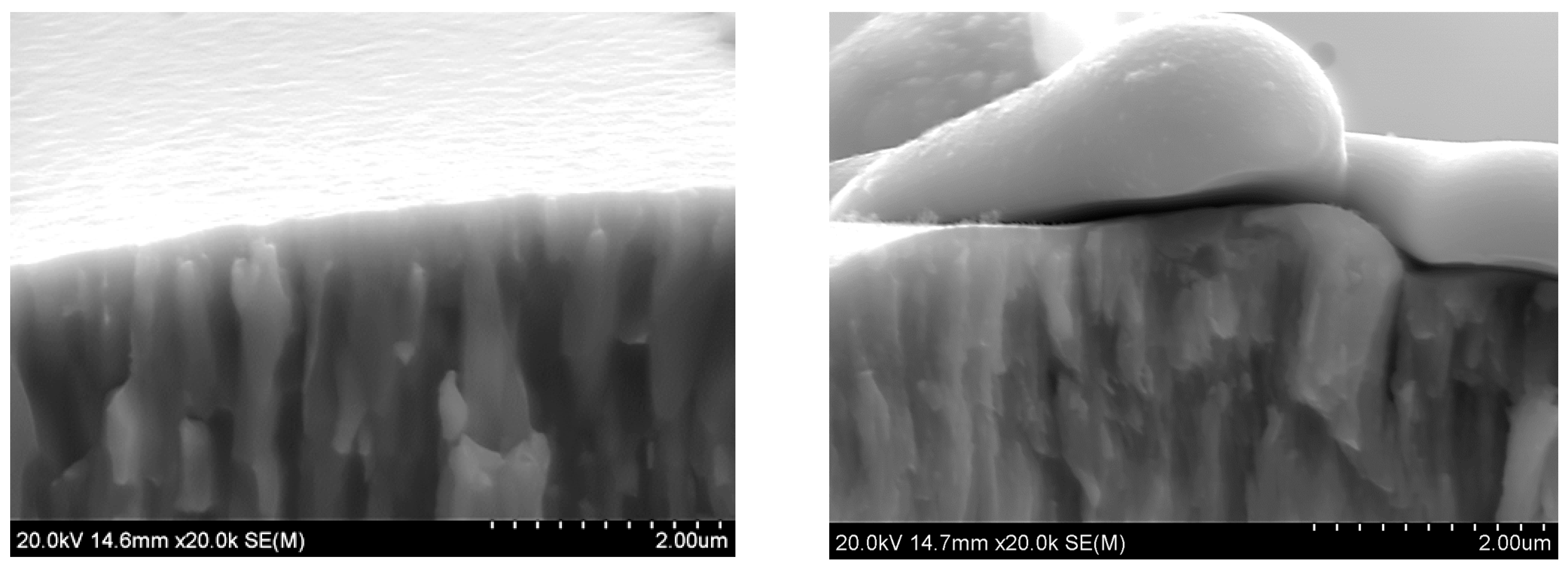
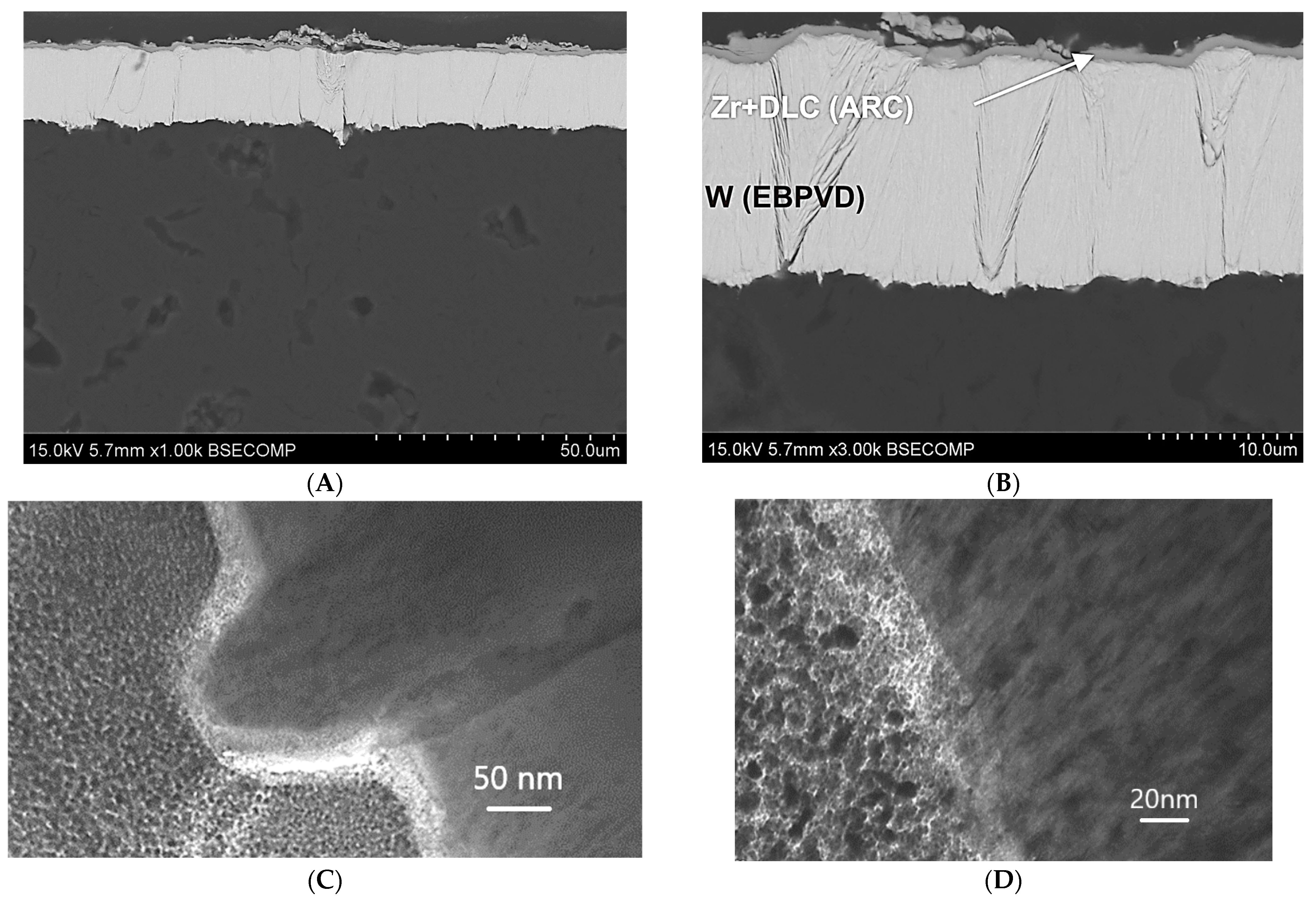
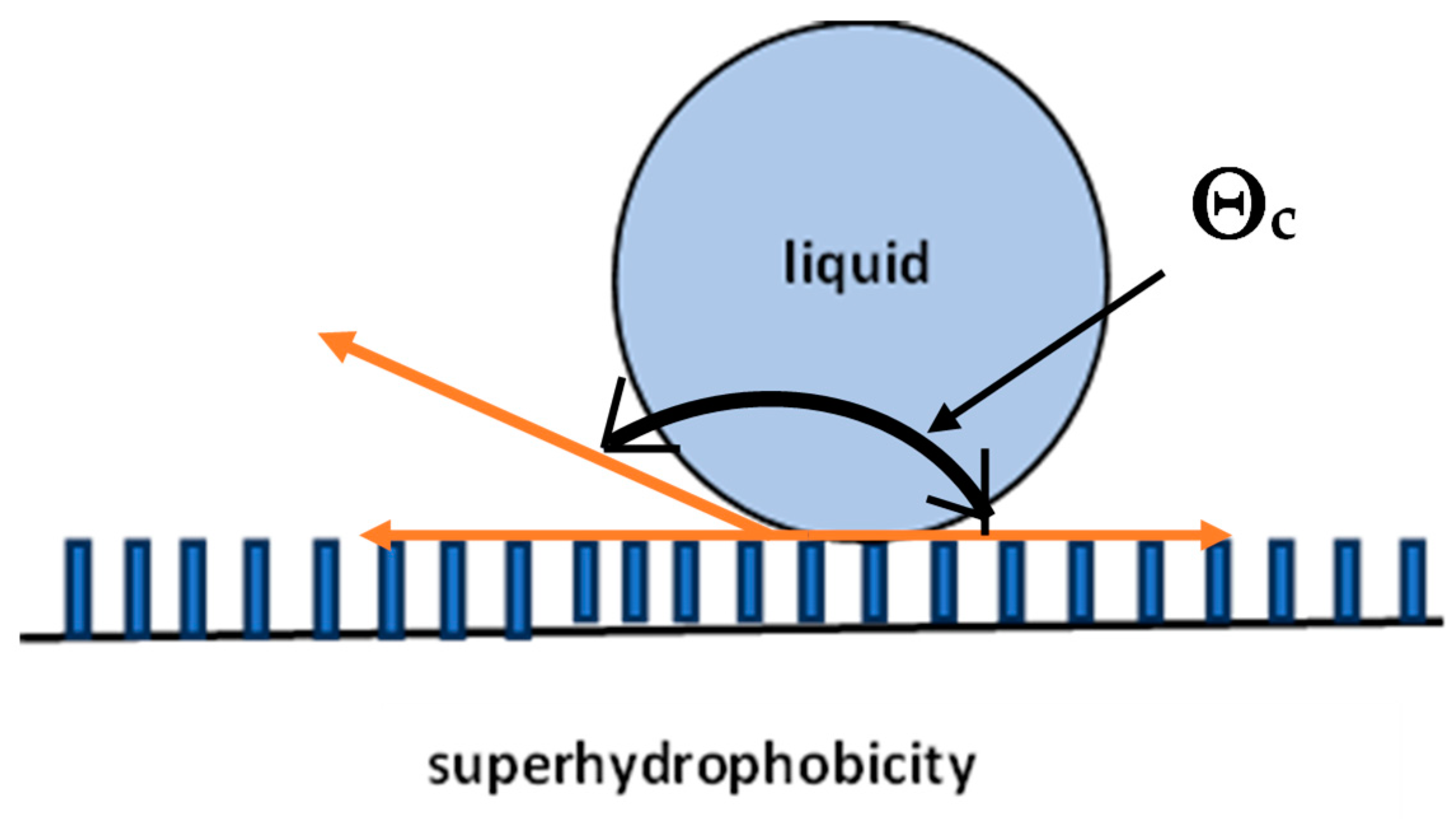

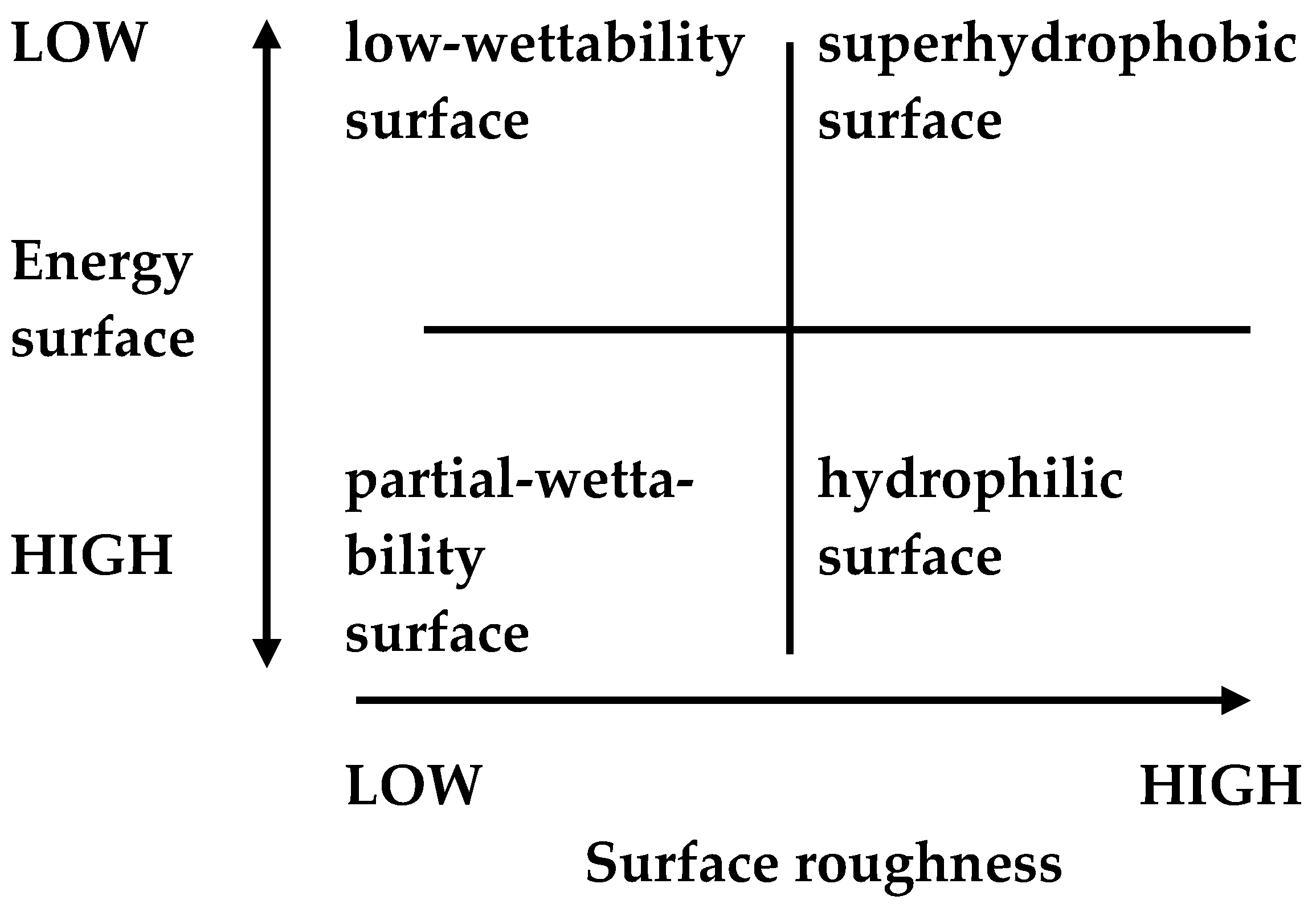

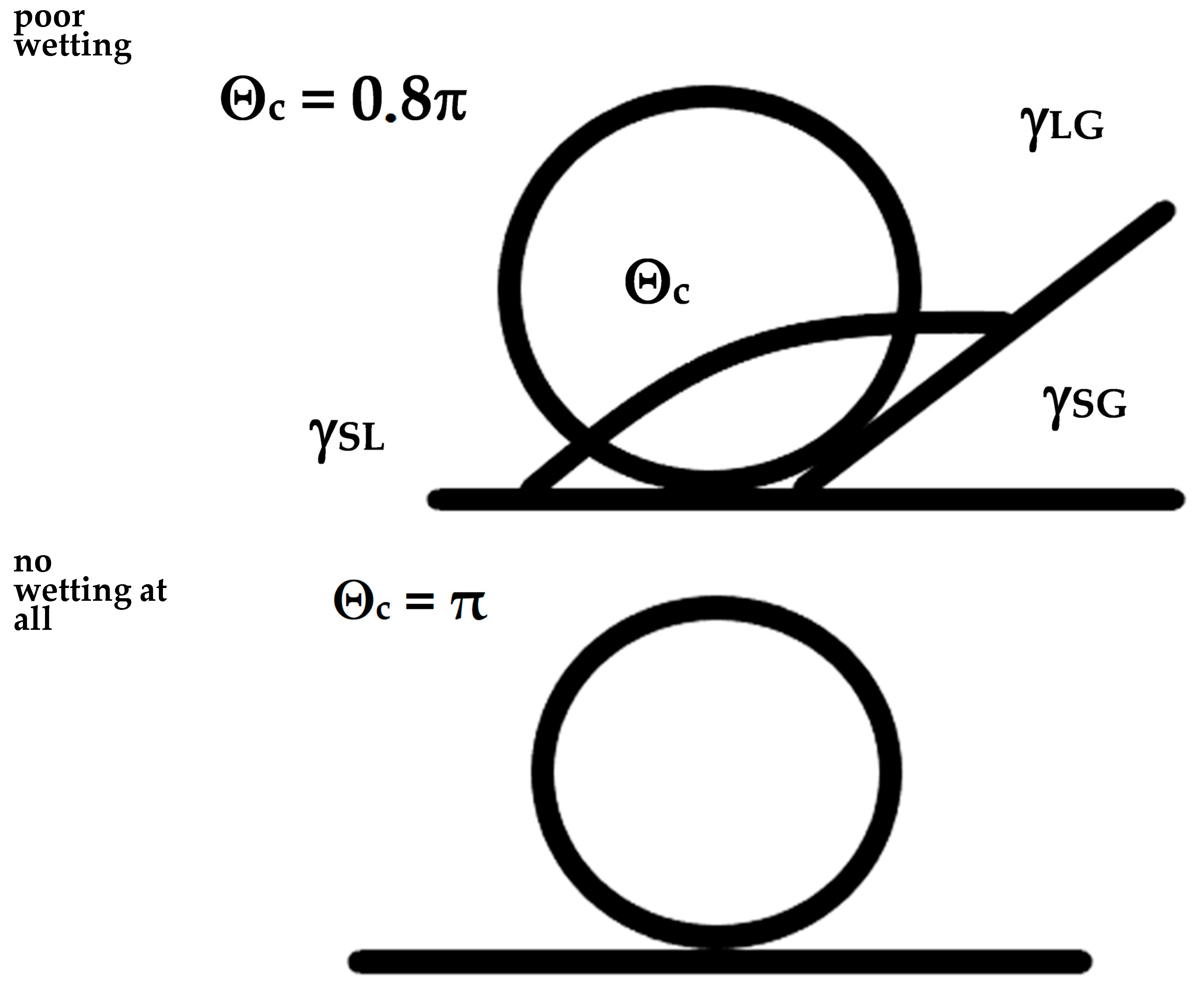
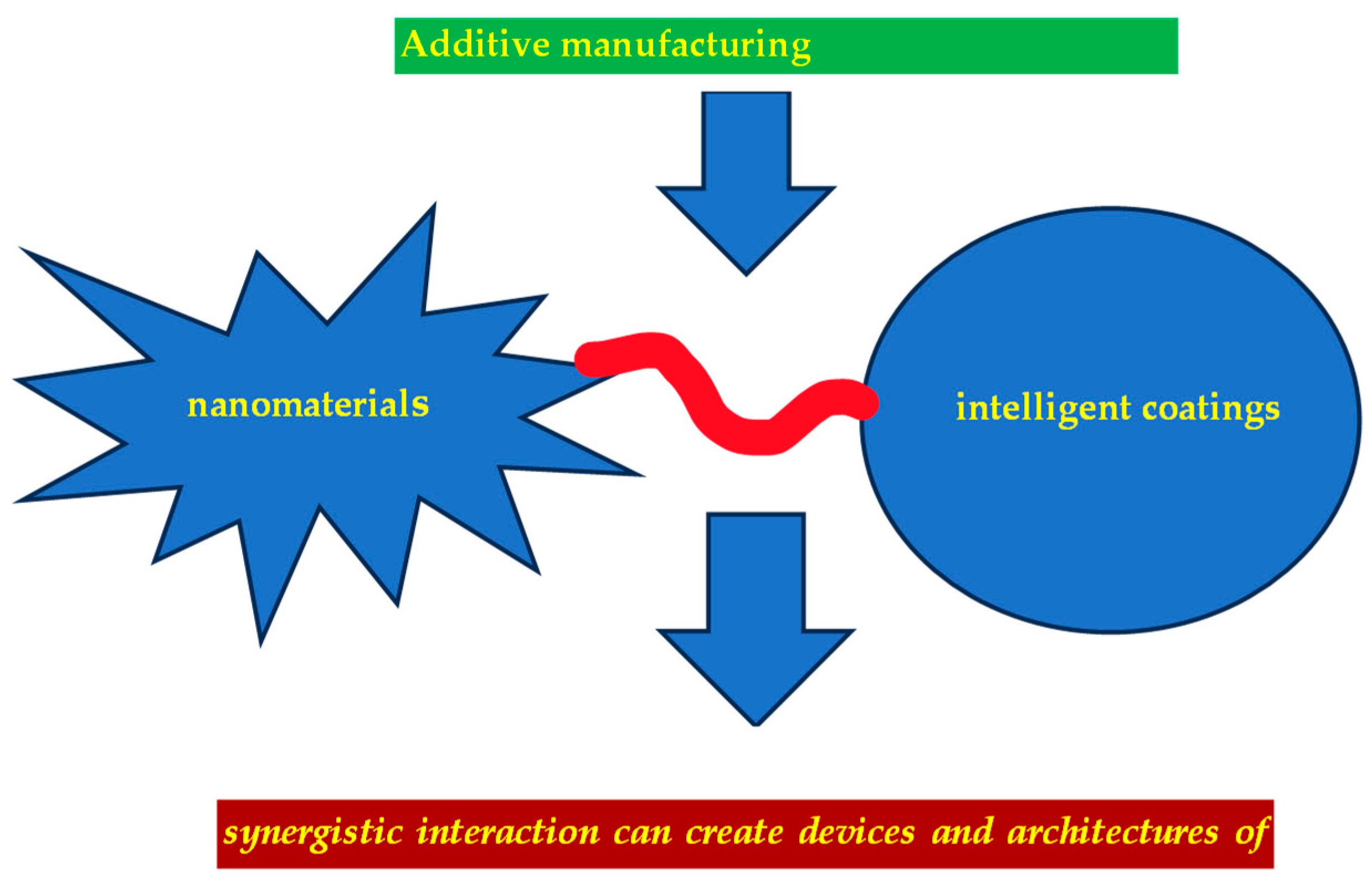


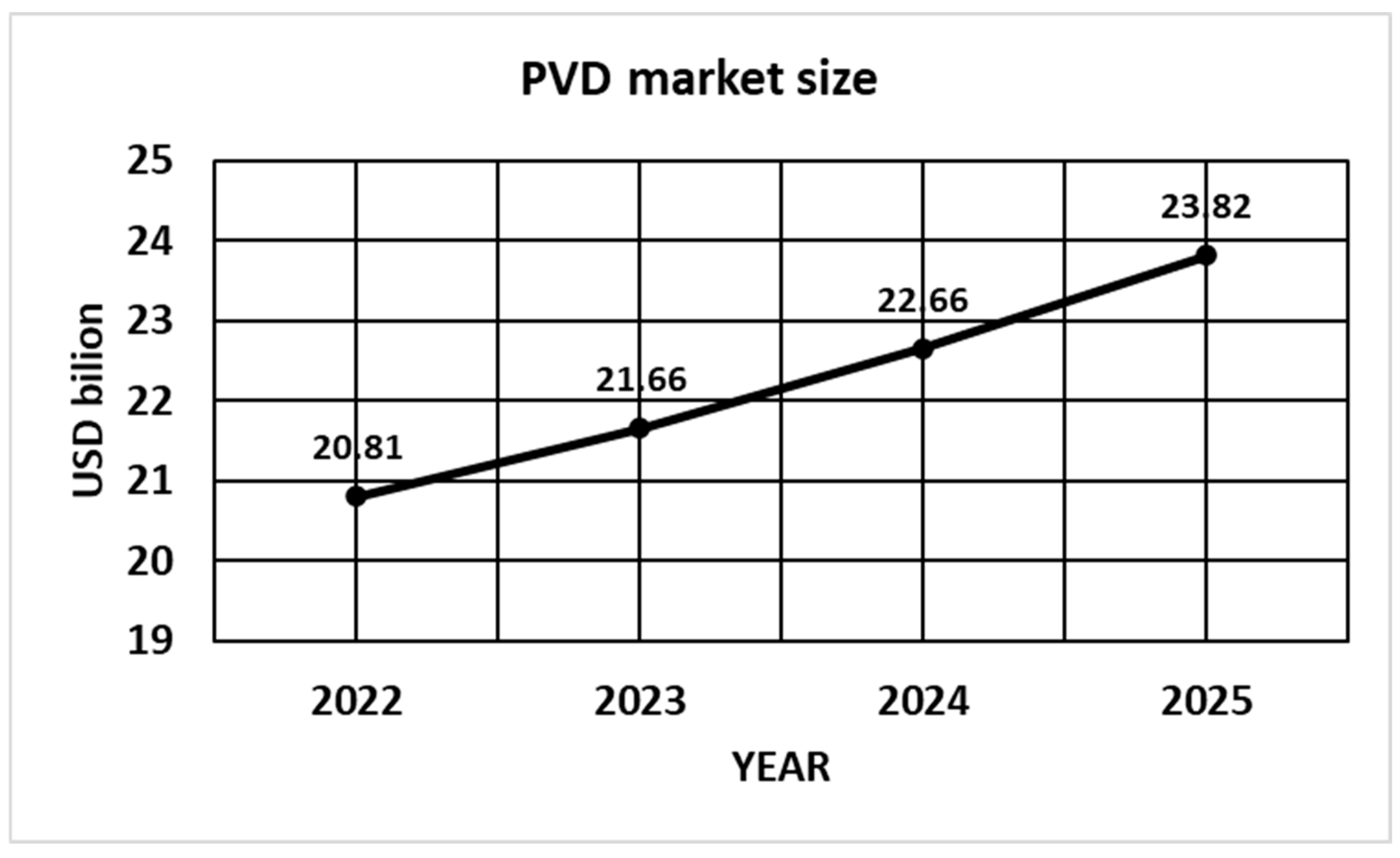

| Psyhical Vapor Deposition (PVD) | PVD is characterized by a process in which the material goes from a condensed phase to a vapor phase and then back to a thin film condensed phase. Advantages—PVD coatings are thin layers and range from 1 to 15 microns, it is the most common technology for treating metal surfaces, precise control of coating thickness, very good adhesion of the coating to the substrate, high smoothness of the coating, resistance to damage, scratches, discoloration, and abrasion, extremely hard and scratch-resistant, a large selection of surface coating materials, thermal shock resistance. Disadvantages—the complexity of coating equipment, high process requirements and long coating times, susceptibility to internal stresses and microcracks due to different shrinkage of the coating and the substrate during cooling. | 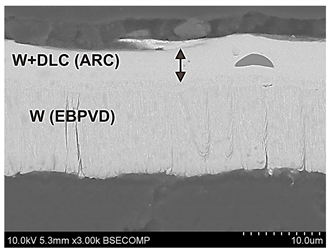 Tungsten coating deposited by electron beam physical vapor deposition (EBPVD) method, on the top W+DLC coating deposited by Cathodic Arc Deposition—(ARC PVD) method |
| Chemical Vapor Deposition (CVD) | CVD is a materials processing technology in which thin films are formed on a heated substrate via a chemical reaction of gas-phase precursors. Advantages—great resistance to high temperatures, high mechanical strength, very good adhesion to the substrate. Disadvantages—the surface is not as smooth as PVD, so the workpiece may stick, susceptibility to thermal shock compared to PVD coatings, the thickness of the coating causes a large rounding of the cutting edge, although this is not always a problem, the complexity of coating equipment, the process is often used in the semiconductor industry to produce thin films, high process temperature reduces the impact strength of the tool in the surface area. |  Tungsten coating on In 738 substrate deposited by CVD method |
| Galvanic Coatings (GCs) | Galvanic coatings are created in the galvanization process (or more precisely, electroplating), which involves creating coatings using an electrolytic method, most often on metal products. Advantages—coatings can be made of most metals and alloys, high durability of galvanic coatings, high resistance to corrosion and material abrasion, possibility of applying the technology to elements with extremely complex shapes, improving the thermal or electrical properties of processed parts, excellent visual effect for decorative coatings, electroplating treatment is widely used in industry. Disadvantages—the galvanization process requires prior preparation of the treated surface, which most often involves degreasing and cleaning it, the need to use chemicals that are often harmful to the environment, defects may appear, e.g., those resembling orange peel, if the process is not carried out properly. |  Galvanic coating on an In 738 substrate—CoRe galvanic coating (3 µm) and et the top CVD aluminum layer |
| Thermal Spray Coating (TSC) | In TSC technology, the coating material in the form of wire or powder is delivered to the metallization device, where it is melted and then directed at a high speed in a plasma stream to the substrate to form the coating. Advantages—widely used, the technology enables the spraying of thermally sensitive materials and very different material combinations because the adhesion mechanism is purely mechanical, high thermal and electrical conductivity of coatings, high density and hardness of coatings, high uniformity of coatings, no melting, possibility of spraying fine particles (5–10 μm), possibility of spraying nanomaterials and amorphous materials, minimal surface preparation, low energy consumption, possibility of obtaining complex shapes and internal surfaces, high efficiency thanks to high power factor, high settling rates and efficiency, no toxic waste, increased operational safety due to the absence of high-temperature gas streams and radiation. Disadvantages—almost zero plasticity in the sprayed state, the need for a plastic substrate, difficulties in processing pure ceramics and some alloys such as hardening alloys, high cost of helium, nozzle contamination and erosion, should not be used in conditions of high point loads (e.g., ball and needle bearing races) and impacts, coatings may be porous. |  WC-CrC-Ni coating deposited by thermal spraying method |
| Base Coat (Paint Color) | ~10–25 Mikrons, Vehicle Color Layer |
| Primer | ~20–30 mikrons creates uniform and smooth surface for base coat, promotes layer adhesion |
| E-COAT | ~20 mikrons, deposited only on metal, corrosion protection |
| Phosphate | ~5 mikron, deposited only on metal, corrosion protection, promotes adhesion |
| Substrate | (metal, plastic, carbon fiber, etc.) |
| anodizing | various colors but predominantly silver or black is used for the automotive trade; with the increased use of aluminum, anodizing has also significantly increased in automotive applications |
| powder coating | powder coating offers many advantages over the traditional painting process: blocks and heads can be powder-coated immediately after the casting process, which avoids the cleaning step, the powder adheres to raw castings without the need for pre-treatment, and the resins used in powder coating have a higher molecular weight, which ensures a higher quality finish of machined parts. |
| chrome-free chemical conversion coating | car conversion coatings consist of layers of materials that are chemically applied to vehicle body structures prior to painting to improve corrosion protection and increase paint adhesion; these coatings are a consequence of chemical reactions on the surface and are placed between the paint layers and the base metal |
| E-coating (electrical immersive painting) | an electrocoat system applies a DC charge to a metal part immersed in a bath of oppositely charged paint particles; the paint particles are drawn to the metal part and paint is deposited on its surface, forming an even, continuous film over every curve, crevice, and corner, until the electrocoat reaches the desired thickness. |
Disclaimer/Publisher’s Note: The statements, opinions and data contained in all publications are solely those of the individual author(s) and contributor(s) and not of MDPI and/or the editor(s). MDPI and/or the editor(s) disclaim responsibility for any injury to people or property resulting from any ideas, methods, instructions or products referred to in the content. |
© 2024 by the authors. Licensee MDPI, Basel, Switzerland. This article is an open access article distributed under the terms and conditions of the Creative Commons Attribution (CC BY) license (https://creativecommons.org/licenses/by/4.0/).
Share and Cite
Richert, M.; Dudek, M.; Sala, D. Surface Quality as a Factor Affecting the Functionality of Products Manufactured with Metal and 3D Printing Technologies. Materials 2024, 17, 5371. https://doi.org/10.3390/ma17215371
Richert M, Dudek M, Sala D. Surface Quality as a Factor Affecting the Functionality of Products Manufactured with Metal and 3D Printing Technologies. Materials. 2024; 17(21):5371. https://doi.org/10.3390/ma17215371
Chicago/Turabian StyleRichert, Maria, Marek Dudek, and Dariusz Sala. 2024. "Surface Quality as a Factor Affecting the Functionality of Products Manufactured with Metal and 3D Printing Technologies" Materials 17, no. 21: 5371. https://doi.org/10.3390/ma17215371
APA StyleRichert, M., Dudek, M., & Sala, D. (2024). Surface Quality as a Factor Affecting the Functionality of Products Manufactured with Metal and 3D Printing Technologies. Materials, 17(21), 5371. https://doi.org/10.3390/ma17215371








